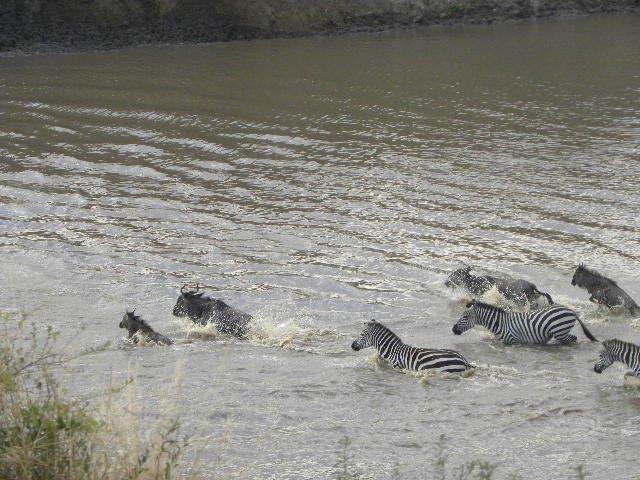Weather
Dry but with very cold early mornings - temperatures
as low as 15 degrees Celsius. The day warms up to 30 degrees Celsius.
Evenings get cool with temperatures at 18 degrees
Celsius.
Rivers
There have been no rains in the Mara for some weeks except
in the northern and eastern parts which has made it possible for the rivers like
the Talek and the Olare Orok to swell and flow.
The Mara River – the life-lung of the Mara – is quite
high meaning that there is some rain in the Mau forest - the source of the
river.
Wildlife
With
the onset of the migration, there is spectacular wildlife with the big herds of
wildebeest and zebra spread all over the savanna grasslands.
There
have been fantastic crossings over the Mara River with lots of wildebeest and
zebras crossing at different points. All seem to be heading towards the Mara Triangle
and to the salt lick at Enkoiguaate at the base of the Oloololo Escarpment.
This area is very lush because it was burnt recently before the rain for fresh
grass to regrow.
Some
of the crossings have been at Lookout Crossing and Paradise Crossing.
At
Rhino Ridge and Topi Plains near Mara Intrepids and Mara Explorer camps there
are several hundreds of wildebeest and zebra making their way to the Mara River.
An interesting observation: An albino
zebra on the southern side of the Mara Intrepids and Explorer camps.
During
the annual migration of the wildebeest from the Serengeti, elephants tend to
move to less crowded areas but there have been sightings of families of up to
15 individuals by the riverine forests in search of pasture as there is hardly
anything for them to eat on the plains.
Rhinos
have been seen at Olkeju Rongai and around Chemarta.
Buffalos
are common but out-numbered by the migrating wildebeest and zebras. Several
hundreds’ are calving.
Eland
are also common by the sundowner site by the camp.
Giraffe,
impala and gazelles are in plenty despite the dry season.
Predators
Lions
Ridge Pride: doing very well with the pride growing in size with a
new set of cubs. Most of the adult females are also pregnant.
The
pride has been at Double Crossing and having a great time hunting wildebeest
every two days. The three sub-adult males (Mandevu) and their sister Ashlina
seem to be getting pushed out of the pride. They have been seen on their own
trying to hunt near Rhino Ridge. The dominant males - Blacky and Lipstick- are
still in charge of the pride, going strong.
Paradise Pride and the Rekero breakaways: Doing great. They have several cubs.
The
Musketeers are in charge of both
prides. The prides are around Paradise Crossing and Chemarta hunting wildebeest
and zebras.
Long Face who was the dominant male for the Maji ya Eland pride has been loitering
around Rekero Crossing and Smelly Crossing. He seems unsettled since he was
pushed out of his pride by the four nomads. He was last seen alone at Smelly Crossing.
Lookout Pride: Is below Lookout Hill doing well with the Notch boys in charge though they seem
to be getting frail due to old age.
Cheetahs
The
coalition of five male cheetahs who are of different ages have been giving us
some very good sightings in most parts of the park.
They
are also hunting wildebeest and at times they have made multiple kills. They
seem to move a lot at night. They moved into the Olare Orok Conservancy for a
night and the next day they were seen at Olkeju Rongai which is quite a
distance for them to cover in a night.
Imani has left her cubs. The cubs are moving around Rhino Ridge, Possee Plains
and Maji ya Eland. They have been successfully hunting - though the kills are
small and sometimes they lose them to hyenas.
Malaika - the grand
dame of Mara - and her two cubs
are also in the same area but a bit further at Concrete Crossing near Lookout Hill.
The cubs seem to be doing well but Malaika is getting weak and less efficient at
hunting.
Leopards
Bahati: She and her two cubs have been elusive and spotted only once at Mara
Intrepids’ Swing Bridge across the Talek River.
Her
elder son Safarilink was seen in the
same area. They are doing fine and the little cubs are growing.
Kaboso and her two cubs and the older cub are doing very well. They have been
seen together sharing kills.
This
family has been roaming between Olare Orok River and Kaboso crossing point.
They have been hunting wildebeest calves as they cross the rivers.
News alert!
African Wild Dog
We
had another rare sighting of a lone hunting dog at Double Crossing who was a
bit nervous, running up and down.
The
African hunting dog has a satellite collar fitted by researchers to learn more
about his movements.
In
the early 20th century, the African hunting dog was almost shot to
extinction as farmers saw it as vermin.
Numbers
are now on the increase.
Senior driver-guide at Mara
Intrepids Camp
By
Raphael Koikai


















No comments:
Post a Comment